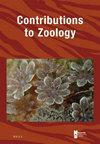Renewed perspectives on the sedentary-pelagic last common bilaterian ancestor
IF 2.2
2区 生物学
Q1 ZOOLOGY
引用次数: 1
Abstract
Various evaluations of the last common bilaterian ancestor (lcba) currently suggest that it resembled either a microscopic, non-segmented motile adult; or, on the contrary, a complex segmented adult motile urbilaterian. These fundamental inconsistencies remain largely unexplained. A majority of multidisciplinary data regarding sedentary adult ancestral bilaterian organization is overlooked. The sedentary-pelagic model is supported now by a number of novel developmental, paleontological and molecular phylogenetic data: (1) data in support of sedentary sponges, in the adult stage, as sister to all other Metazoa; (2) a similarity of molecular developmental pathways in both adults and larvae across sedentary sponges, cnidarians, and bilaterians; (3) a cnidarian-bilaterian relationship, including a unique sharing of a bona fide Hox-gene cluster, of which the evolutionary appearance does not connect directly to a bilaterian motile organization; (4) the presence of sedentary and tube-dwelling representatives of the main bilaterian clades in the early Cambrian; (5) an absence of definite taxonomic attribution of Ediacaran taxa reconstructed as motile to any true bilaterian phyla; (6) a similarity of tube morphology (and the clear presence of a protoconch-like apical structure of the Ediacaran sedentary Cloudinidae) among shells of the early Cambrian, and later true bilaterians, such as semi-sedentary hyoliths and motile molluscs; (7) recent data that provide growing evidence for a complex urbilaterian, despite a continuous molecular phylogenetic controversy. The present review compares the main existing models and reconciles the sedentary model of an urbilaterian and the model of a larva-like lcba with a unified sedentary(adult)-pelagic(larva) model of the lcba.对静止-远洋最后的共同双边祖先的新观点
目前,对最后一个常见的双侧祖先(lcba)的各种评估表明,它类似于一个微观的、不分节的能动成虫;或者,恰恰相反,是一个复杂的分段的成年运动性涡轮侧索。这些根本的不一致在很大程度上仍然无法解释。大多数关于久坐的成人祖先双侧组织的多学科数据被忽视了。定居的浮游动物模型现在得到了一些新的发育、古生物学和分子系统发育数据的支持:(1)支持成年阶段定居海绵作为所有其他后生动物的姐妹的数据;(2) 成虫和幼虫的分子发育途径在久坐海绵、线虫和双边动物中的相似性;(3) cnidarian双边关系,包括真正的Hox基因簇的独特共享,其进化外观与双边能动组织没有直接联系;(4) 寒武纪早期主要双边分支的定居和管栖代表的存在;(5) 埃迪卡拉纪分类群缺乏明确的分类归属,被重建为任何真正的双边门;(6) 早寒武纪和后来的真正双边动物(如半定居舌石和活动软体动物)的外壳之间的管状形态相似(以及埃迪卡拉纪定居云科明显存在原球茎状顶端结构);(7) 尽管存在持续的分子系统发育争议,但最近的数据为复杂的涡虫提供了越来越多的证据。本综述比较了现有的主要模型,并将涡虫的定居模型和幼虫样lcba的模型与lcba的统一定居(成年)-浮游(幼虫)模型进行了协调。
本文章由计算机程序翻译,如有差异,请以英文原文为准。
求助全文
约1分钟内获得全文
求助全文
来源期刊

Contributions to Zoology
生物-动物学
CiteScore
4.00
自引率
4.50%
发文量
16
审稿时长
>12 weeks
期刊介绍:
Contributions to Zoology solicits high-quality papers in all systematics-related branches of comparative zoology (including paleozoology). Preference will be given to manuscripts dealing with conceptual issues and to integrative papers (e.g., ecology and biodiversity, morphology and phylogeny and character state evolution, phylogeny and historical biogeography, systematics and bioinformatics, bioinformatics and biodiversity, habitat disturbance and biogeography, etc.). Reviews and alpha-taxonomic contributions are considered for publication, but acceptance will depend on their high quality and exceptional nature.
 求助内容:
求助内容: 应助结果提醒方式:
应助结果提醒方式:


